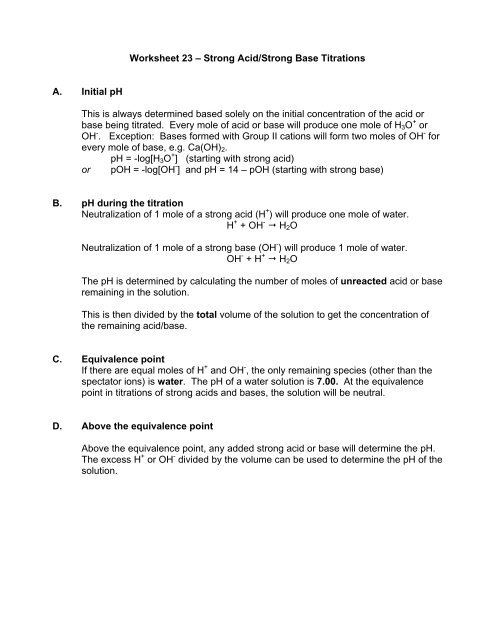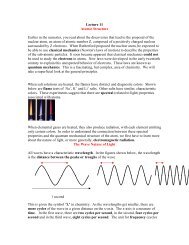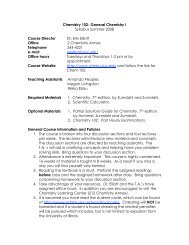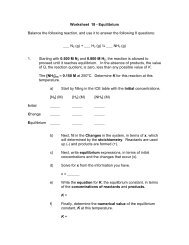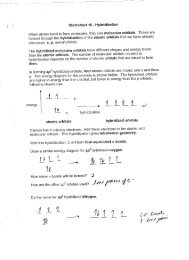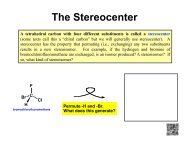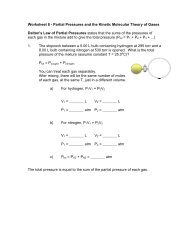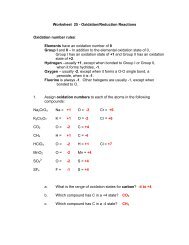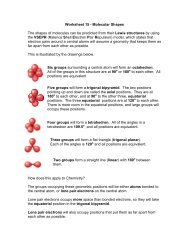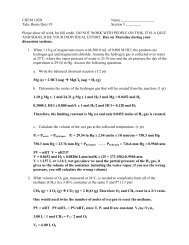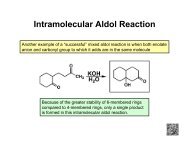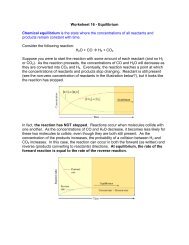Worksheet 23 â Strong Acid/Strong Base Titrations A. Initial pH This ...
Worksheet 23 â Strong Acid/Strong Base Titrations A. Initial pH This ...
Worksheet 23 â Strong Acid/Strong Base Titrations A. Initial pH This ...
You also want an ePaper? Increase the reach of your titles
YUMPU automatically turns print PDFs into web optimized ePapers that Google loves.
<strong>Worksheet</strong> <strong>23</strong> – <strong>Strong</strong> <strong>Acid</strong>/<strong>Strong</strong> <strong>Base</strong> <strong>Titrations</strong><br />
A. <strong>Initial</strong> <strong>pH</strong><br />
<strong>This</strong> is always determined based solely on the initial concentration of the acid or<br />
base being titrated. Every mole of acid or base will produce one mole of H 3 O + or<br />
OH - . Exception: <strong>Base</strong>s formed with Group II cations will form two moles of OH - for<br />
every mole of base, e.g. Ca(OH) 2 .<br />
<strong>pH</strong> = -log[H 3 O + ] (starting with strong acid)<br />
or pOH = -log[OH - ] and <strong>pH</strong> = 14 – pOH (starting with strong base)<br />
B. <strong>pH</strong> during the titration<br />
Neutralization of 1 mole of a strong acid (H + ) will produce one mole of water.<br />
H + + OH - H 2 O<br />
Neutralization of 1 mole of a strong base (OH - ) will produce 1 mole of water.<br />
OH - + H + H 2 O<br />
The <strong>pH</strong> is determined by calculating the number of moles of unreacted acid or base<br />
remaining in the solution.<br />
<strong>This</strong> is then divided by the total volume of the solution to get the concentration of<br />
the remaining acid/base.<br />
C. Equivalence point<br />
If there are equal moles of H + and OH - , the only remaining species (other than the<br />
spectator ions) is water. The <strong>pH</strong> of a water solution is 7.00. At the equivalence<br />
point in titrations of strong acids and bases, the solution will be neutral.<br />
D. Above the equivalence point<br />
Above the equivalence point, any added strong acid or base will determine the <strong>pH</strong>.<br />
The excess H + or OH - divided by the volume can be used to determine the <strong>pH</strong> of the<br />
solution.
1. Consider the titration of 50.0 mL of 2.0 M HNO 3 with 1.0 M KOH.<br />
At each step of the titration...<br />
a) write a reaction to show the initial reaction upon mixing<br />
b) construct an ICE table to represent the reaction<br />
(Should you use concentration or moles?)<br />
c) determine the major species present after the reaction is complete<br />
d) calculate the <strong>pH</strong> of the solution<br />
Complete these steps for the addition of 0.0 mL, 25.0 mL, 50.0 mL, 90.0 mL,<br />
100.0 mL, 110.0 mL and 150.0 mL of 1.0 M KOH.<br />
0.0 mL KOH<br />
a) HNO 3 + H 2 O NO 3 - + H 3 O +<br />
b) [HNO 3 ] [NO - 3 ] [H 3 O + ]<br />
<strong>Initial</strong> 2.0 0 0<br />
Change -2.0 +2.0 +2.0<br />
Equil. 0 2.0 2.0<br />
<strong>This</strong> ICE table uses units of concentration because the volume is fixed<br />
c) The major species present at equilibrium are H 2 O, NO 3 - and H 3 O +<br />
d) <strong>pH</strong> is calculated using the concentration of [H 3 O + ]<br />
+<br />
H O = 2.0 M<br />
[ ]<br />
3<br />
<strong>pH</strong> = −log<br />
( 2.0) = −0.<br />
30
25.0 mL KOH<br />
a) The major reaction (ignoring spectator ions) is a neutralization:<br />
H + + OH - H 2 O<br />
b) <strong>This</strong> ICE table uses units of moles because the volume changes when the<br />
KOH is added<br />
+<br />
+<br />
2.0 mol HNO3<br />
1mol H<br />
+<br />
mol H = 0.050 L ×<br />
×<br />
= 0.100 mol H<br />
1L 1mol HNO<br />
3<br />
-<br />
-<br />
1.0 mol NaOH 1.0 mol OH<br />
mol OH = 0.025 L ×<br />
×<br />
=<br />
1L<br />
1.0 mol NaOH<br />
0.025 mol OH<br />
[H + ] [OH - ] [H 2 O]<br />
<strong>Initial</strong> 0.100 0.025<br />
Change -0.025 -0.025<br />
Equil. 0.075 0<br />
c) The major species present at equilibrium are H 2 O, K + , NO 3 - and H +<br />
d) <strong>pH</strong> is calculated using the concentration of [H + ]<br />
+ 0.075 moles<br />
[ H ] =<br />
= 1.0<br />
0.050 + 0.025 mL<br />
<strong>pH</strong> = − log 1.0 =<br />
( ) 0<br />
-<br />
50.0 mL KOH<br />
a) H + + OH - H 2 O<br />
b) <strong>This</strong> ICE table uses units of moles because the volume changes when the<br />
KOH is added<br />
-<br />
-<br />
1.0 mol NaOH 1.0 mol OH<br />
-<br />
mol OH = 0.050 L ×<br />
×<br />
= 0.050 mol OH<br />
1L 1.0 mol NaOH<br />
[H + ] [OH - ] [H 2 O]<br />
<strong>Initial</strong> 0.100 0.050<br />
Change -0.050 -0.050<br />
Equil. 0.050 0<br />
c) The major species present at equilibrium are H 2 O, K + , NO 3 - and H +<br />
d) <strong>pH</strong> is calculated using the concentration of [H + ]<br />
+ 0.050 moles<br />
[ H ] =<br />
= 0.50<br />
0.050 + 0.050 mL<br />
<strong>pH</strong> = −log<br />
0.50 = 0.<br />
( ) 30
90.0 mL KOH<br />
a) H + + OH - H 2 O<br />
b) <strong>This</strong> ICE table uses units of moles because the volume changes when the<br />
KOH is added<br />
-<br />
-<br />
1.0 mol NaOH 1.0 mol OH<br />
-<br />
mol OH = 0.090 L ×<br />
×<br />
= 0.090 mol OH<br />
1L 1.0 mol NaOH<br />
[H + ] [OH - ] [H 2 O]<br />
<strong>Initial</strong> 0.100 0.090<br />
Change -0.090 -0.090<br />
Equil. 0.090 0<br />
c) The major species present at equilibrium are H 2 O, K + , NO 3 - and H +<br />
d) <strong>pH</strong> is calculated using the concentration of [H + ]<br />
+ 0.090 moles<br />
[ H ] =<br />
= 0.0714<br />
0.050 + 0.090 mL<br />
<strong>pH</strong> = −log<br />
0.0714 = 1.<br />
( ) 15<br />
100.0 mL KOH<br />
a) H + + OH - H 2 O<br />
b) <strong>This</strong> ICE table uses units of moles because the volume changes when the<br />
KOH is added<br />
-<br />
-<br />
1.0 mol NaOH 1.0 mol OH<br />
-<br />
mol OH = 0.100 L ×<br />
×<br />
= 0.100 mol OH<br />
1L 1.0 mol NaOH<br />
[H + ] [OH - ] [H 2 O]<br />
<strong>Initial</strong> 0.100 0.100<br />
Change -0.100 -0.100<br />
Equil. 0 0<br />
c) The major species present at equilibrium are H 2 O, K + , NO 3<br />
-<br />
d) The solution has been completely neutralized, and the <strong>pH</strong> is 7
110.0 mL KOH<br />
a) H + + OH - H 2 O<br />
b) <strong>This</strong> ICE table uses units of moles because the volume changes when the<br />
KOH is added<br />
-<br />
-<br />
1.0 mol NaOH 1.0 mol OH<br />
-<br />
mol OH = 0.110 L ×<br />
×<br />
= 0.110 mol OH<br />
1L 1.0 mol NaOH<br />
[H + ] [OH - ] [H 2 O]<br />
<strong>Initial</strong> 0.100 0.110<br />
Change -0.100 -0.100<br />
Equil. 0 0.010<br />
c) The major species present at equilibrium are H 2 O, K + , NO 3 - and OH -<br />
d) <strong>pH</strong> is calculated using the concentration of [OH - ]<br />
− 0.010 moles<br />
[ OH ] =<br />
= 0.0625<br />
0.050 + 0.110 mL<br />
pOH = − log 0.0625 = 1.20<br />
<strong>pH</strong> = 14 − pOH<br />
( )<br />
= 12.8<br />
150.0 mL KOH<br />
a) H + + OH - H 2 O<br />
b) <strong>This</strong> ICE table uses units of moles because the volume changes when the<br />
KOH is added<br />
-<br />
-<br />
1.0 mol NaOH 1.0 mol OH<br />
-<br />
mol OH = 0.150 L ×<br />
×<br />
= 0.150 mol OH<br />
1L 1.0 mol NaOH<br />
[H + ] [OH - ] [H 2 O]<br />
<strong>Initial</strong> 0.100 0.150<br />
Change -0.100 -0.100<br />
Equil. 0 0.050<br />
c) The major species present at equilibrium are H 2 O, K + , NO 3 - and OH -<br />
d) <strong>pH</strong> is calculated using the concentration of [OH - ]<br />
− 0.050 moles<br />
[ OH ] =<br />
= 0.25<br />
0.050 + 0.150 mL<br />
pOH = − log 0.25 = 0.602<br />
( )<br />
<strong>pH</strong> = 14 − pOH<br />
= 13.4
2. Create a titration curve by plotting the <strong>pH</strong> of the solution (y-axis) vs the volume of KOH<br />
added (x-axis) for the titration described in question #1.<br />
<strong>pH</strong> of a strong acid/strong base titration<br />
<strong>pH</strong><br />
14<br />
13<br />
12<br />
11<br />
10<br />
9<br />
8<br />
7<br />
6<br />
5<br />
4<br />
3<br />
2<br />
1<br />
0<br />
-1<br />
0 10 20 30 40 50 60 70 80 90 100 110 120 130 140 150<br />
Volume KOH added (mL)<br />
3. Create a titration curve by plotting the <strong>pH</strong> of the solution (y-axis) vs the volume of KOH<br />
added (x-axis) for the titration of HNO 2 from the previous worksheet. How does the<br />
curve for a strong acid titration compare to that of a weak acid titration?<br />
<strong>pH</strong> of a weak acid/strong base titration<br />
<strong>pH</strong><br />
14<br />
13<br />
12<br />
11<br />
10<br />
9<br />
8<br />
7<br />
6<br />
5<br />
4<br />
3<br />
2<br />
1<br />
0<br />
0 10 20 30 40 50 60 70 80 90 100 110 120 130 140 150<br />
Volume KOH added (mL)<br />
The strong acid/strong base curve starts at a lower <strong>pH</strong> because it begins as a strong acid solution.<br />
Beyond the equivalence point, both curves have the same <strong>pH</strong> values because the <strong>pH</strong> depends on the<br />
concentration of the excess KOH. Since the same base was used for both titrations, they have the<br />
same behavior after 100 mL has been added to either acid solution. The equivalence point of the<br />
strong acid/strong base is at <strong>pH</strong> = 7, but the equivalence point of the weak acid/strong base is NOT<br />
at <strong>pH</strong> = 7. The weak acid/strong base titration curve has a buffer zone, while the strong<br />
acid/strong base titration curve does not. (There’s no buffer region in the strong acid/strong base<br />
titration because there is no conjugate weak acid/weak base pair present)


